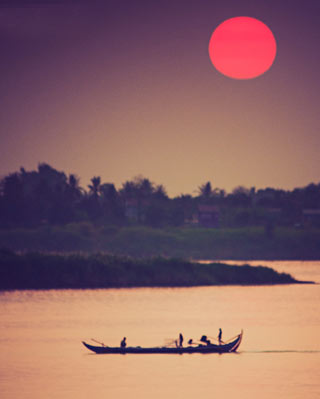Fascinating Insights into Southern Vietnam and Cambodia
The Lower Mekong River connecting Southern Vietnam and Cambodia is likely to be the most diversified cruise destination in Southeast Asia in terms of culture, history, and landscape. Board a multi-day Mekong River cruise, and you will have the great chance to delve deep into these two amazing countries.

NINE DRAGONS RIVER DELTA - The rice bowl of Vietnam
After a long 4,000-km journey through six nations (China, Myanmar, Laos, Thailand, Cambodia, and Vietnam), the Mekong River, the longest in Southeast Asia, splits into nine smaller tributaries, or “dragons,” running through different settlements in southern Vietnam, where life centers around the waterways.

Nearly a fifth of the Vietnamese population (approximately 100 million) lives in the Mekong Delta, and the majority rely on the mighty river for agriculture and fishing. This is feasible because the alluvial deposits are extremely fertile, thanks to the massive volumes of silt and nutrients transported down by the river from the Tibetan Plateau (around 1 billion cubic meters per year). Half of this water is utilized to irrigate the delta's numerous fruit and vegetable farms and rice fields along the shores and regions crisscrossed by a network of canals and rivers.
In fact, the Mekong Delta produces an enormous amount of rice, which makes a name for itself as Vietnam's “rice bowl.” The rice farmed there feeds its citizens and generates enough to make the country the world's third-largest exporter, after India and Thailand.

CLIMATE IN THE LOWER MEKONG RIVER - Beautifully tropical all year round
Any time of year is great for exploring the lower Mekong at the southern trip of Vietnam and Cambodia. Pleasant temperatures and a beautiful sky may be expected throughout December, January, and February, making these months the best and most visited season of the year. March is still an ideal month to travel, with less rain and increasing temperatures. During April and May, temperatures can reach 35°C (95℉).

The rainy season often begins in early June and lasts until October or early November; the weather remains hot, but temperatures are pleasantly decreased due to clouds and rain falls. Showers are likely to be scattered, primarily in the afternoon. However, the summer months offer advantages: the foliage is bursting with vibrant greens, there are fewer visitors, and the Tonle Lake has enough water to allow for a smooth crossing from mid-August to mid-November (time varies each year).

TONLE SAP LAKE & RIVER - Unique waterway flowing in both directions
The Tonle Sap River joins the Mekong in Phnom Penh, where it connects to a vast reservoir and Southeast Asia's biggest inland lake. The Tonle Sap River is unique in the world since it runs in both directions. During the dry season (November to May), the waterway flows downstream. However, as the Mekong River swells during the wet monsoon season, rushing waters follow an alternate north-western path up the Tonle Sap Lake, forming a massive lake and reversing the flow for the rest of the year. The area can span from 2,500 sqkm (965 sqmi) during the dry season to 16,000 sqkm (6,000 sqmi) during the wet monsoon, with depths reaching 10 meters in some parts.

Not only does the lake serve as a safety valve to prevent floods farther downstream in the Mekong, but it also contributes half of the water flow in the delta during the dry season, guaranteeing agricultural activities in the region.
THE KHMER EMPIRE - The lost civilization of Southeast Asia
The Khmer Empire, the forefathers of present-day Cambodians, was established on the banks of the Mekong River at the beginning of the ninth century before finally shifting to Angkor (near modern-day Siem Reap). The Khmer civilization prospered here, feeding its people on the Tonle's plentiful fish and irrigated rice paddies. At its peak between 1000 and 1200 CE, the empire comprised all of modern-day Cambodia, with Angkor serving as the world's greatest urban center at that time. Experts are uncertain what caused the civilization's extinction, leaving its towns at the mercy of the unrelenting forest. Theories vary from war to ecological disaster.

INTERESTING WORLD RECORDS - Top stats of Vietnam and Cambodia
The Mekong River basin is considered to be the world's second-most biodiverse (after the Amazon River), with more than 1200 fish species, including the well-known Mekong giant catfish. It also has the world's largest inland fishery, with Vietnam being the main exporter (1.3 million tons in 2019) of freshwater fish farmed in the region. The mighty Mekong also irrigates southern Vietnam's abundant rice fields and orchards, making the country the leading supplier of dragon fruit and the third largest exporter of rice in the world.

Meanwhile, across the border, Cambodia has a young population and according to the UNDP, youth under the age of 30 account for around 65% of Cambodia's population. The famed Angkor Wat in Siem Reap is the world's biggest religious structure (spanning over 400 acres). The Cambodian flag also features Angkor, which is one of the world's few national flags with a building.
CULTURAL IMMERSION - Local customs one should know in Vietnam and Cambodia
Though locals are typically aware of cultural differences and quite forgiving of foreigners, it’s better to know some basic etiquette when visiting a country in Southeast Asia.
In Cambodia, a person's head should never be touched, as it is the highest part of the body and considered sacred, even if done gently and lovingly. Similarly, pointing the sole of your foot at another individual is considered impolite. While it is customary in Vietnam to extend one's hand as a greeting, Cambodians welcome one another with a “sampeah,” in which the hands are folded together in a Namaste gesture, followed by a head bow.

Other significant customs to be aware of in both countries are: Avoid showing affection in public and wearing skimpy clothing (particularly in places of worship). It is also a good idea to present someone with an object with both hands as a show of respect, and when pointing in a direction, use your hand rather than just your index finger. Finally, take off your shoes and hat before entering a temple or a local home.

The Lower Mekong is a wonderful land of treasures, and a voyage on a Mekong River cruise will surely unveil some to your sight. If you’re considering a river cruise tour between Vietnam and Cambodia, contact us for detailed information on cruise options and great deals that suit you best.
















